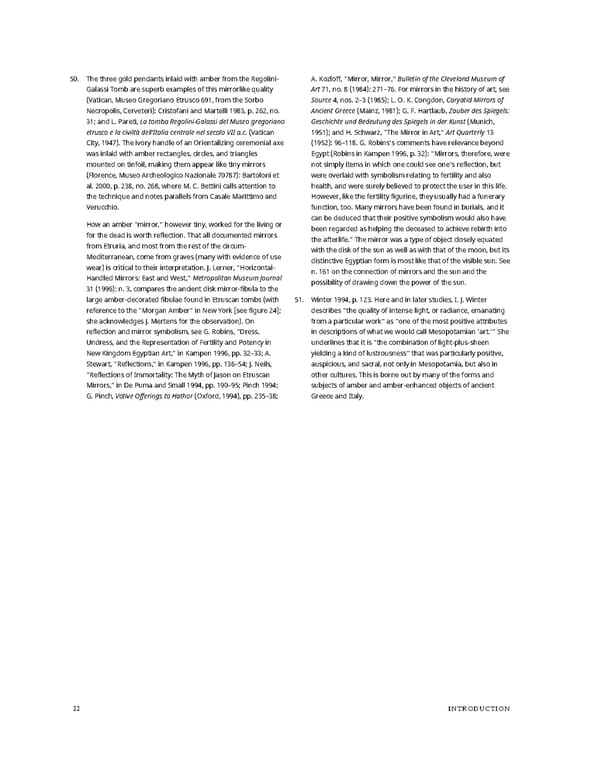50. The three gold pendants inlaid with amber from the Regolini- A. Kozloff, “Mirror, Mirror,” Bulletin of the Cleveland Museum of Galassi Tomb are superb examples of this mirrorlike quality Art 71, no. 8 (1984): 271–76. For mirrors in the history of art, see (Vatican, Museo Gregoriano Etrusco 691, from the Sorbo Source 4, nos. 2–3 (1985); L. O. K. Congdon, Caryatid Mirrors of Necropolis, Cerveteri): Cristofani and Martelli 1983, p. 262, no. Ancient Greece (Mainz, 1981); G. F. Hartlaub, Zauber des Spiegels: 31; and L. Pareti, La tomba Regolini-Galassi del Museo gregoriano Geschichte und Bedeutung des Spiegels in der Kunst (Munich, etrusco e la civiltà dell’Italia centrale nel secolo VII a.c. (Vatican 1951); and H. Schwarz, “The Mirror in Art,” Art Quarterly 13 City, 1947). The ivory handle of an Orientalizing ceremonial axe (1952): 96–118. G. Robins’s comments have relevance beyond was inlaid with amber rectangles, circles, and triangles Egypt (Robins in Kampen 1996, p. 32): “Mirrors, therefore, were mounted on tinfoil, making them appear like tiny mirrors not simply items in which one could see one’s reflection, but (Florence, Museo Archeologico Nazionale 70787): Bartoloni et were overlaid with symbolism relating to fertility and also al. 2000, p. 238, no. 268, where M. C. Bettini calls attention to health, and were surely believed to protect the user in this life. the technique and notes parallels from Casale Marittimo and However, like the fertility figurine, they usually had a funerary Verucchio. function, too. Many mirrors have been found in burials, and it How an amber “mirror,” however tiny, worked for the living or can be deduced that their positive symbolism would also have for the dead is worth reflection. That all documented mirrors been regarded as helping the deceased to achieve rebirth into from Etruria, and most from the rest of the circum- the afterlife.” The mirror was a type of object closely equated Mediterranean, come from graves (many with evidence of use with the disk of the sun as well as with that of the moon, but its wear) is critical to their interpretation. J. Lerner, “Horizontal- distinctive Egyptian form is most like that of the visible sun. See Handled Mirrors: East and West,” Metropolitan Museum Journal n. 161 on the connection of mirrors and the sun and the 31 (1996): n. 3, compares the ancient disk mirror-fibula to the possibility of drawing down the power of the sun. large amber-decorated fibulae found in Etruscan tombs (with 51. Winter 1994, p. 123. Here and in later studies, I. J. Winter reference to the “Morgan Amber” in New York [see figure 24]; describes “the quality of intense light, or radiance, emanating she acknowledges J. Mertens for the observation). On from a particular work” as “one of the most positive attributes reflection and mirror symbolism, see G. Robins, “Dress, in descriptions of what we would call Mesopotamian ‘art.’” She Undress, and the Representation of Fertility and Potency in underlines that it is “the combination of light-plus-sheen New Kingdom Egyptian Art,” in Kampen 1996, pp. 32–33; A. yielding a kind of lustrousness” that was particularly positive, Stewart, “Reflections,” in Kampen 1996, pp. 136–54; J. Neils, auspicious, and sacral, not only in Mesopotamia, but also in “Reflections of Immortality: The Myth of Jason on Etruscan other cultures. This is borne out by many of the forms and Mirrors,” in De Puma and Small 1994, pp. 190–95; Pinch 1994; subjects of amber and amber-enhanced objects of ancient G. Pinch, Votive Offerings to Hathor (Oxford, 1994), pp. 235–38; Greece and Italy. 22 INTRODUCTION
 Ancient Carved Ambers in the J. Paul Getty Museum Page 31 Page 33
Ancient Carved Ambers in the J. Paul Getty Museum Page 31 Page 33